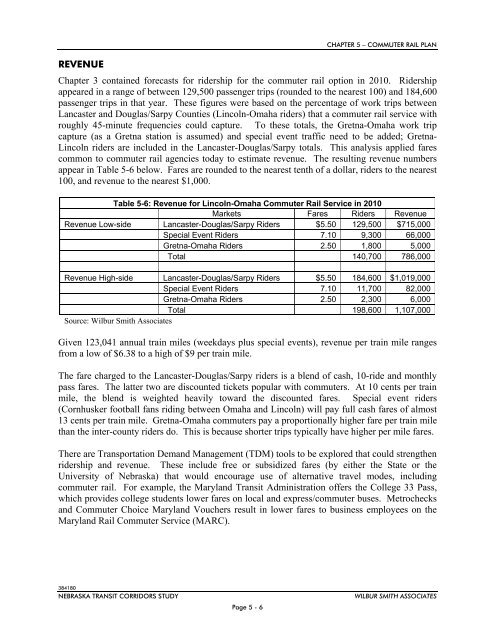NTRAC Final Study - Nebraska Department of Roads - State of ...
NTRAC Final Study - Nebraska Department of Roads - State of ...
NTRAC Final Study - Nebraska Department of Roads - State of ...
Create successful ePaper yourself
Turn your PDF publications into a flip-book with our unique Google optimized e-Paper software.
CHAPTER 5 – COMMUTER RAIL PLAN<br />
REVENUE<br />
Chapter 3 contained forecasts for ridership for the commuter rail option in 2010. Ridership<br />
appeared in a range <strong>of</strong> between 129,500 passenger trips (rounded to the nearest 100) and 184,600<br />
passenger trips in that year. These figures were based on the percentage <strong>of</strong> work trips between<br />
Lancaster and Douglas/Sarpy Counties (Lincoln-Omaha riders) that a commuter rail service with<br />
roughly 45-minute frequencies could capture. To these totals, the Gretna-Omaha work trip<br />
capture (as a Gretna station is assumed) and special event traffic need to be added; Gretna-<br />
Lincoln riders are included in the Lancaster-Douglas/Sarpy totals. This analysis applied fares<br />
common to commuter rail agencies today to estimate revenue. The resulting revenue numbers<br />
appear in Table 5-6 below. Fares are rounded to the nearest tenth <strong>of</strong> a dollar, riders to the nearest<br />
100, and revenue to the nearest $1,000.<br />
Table 5-6: Revenue for Lincoln-Omaha Commuter Rail Service in 2010<br />
Markets Fares Riders Revenue<br />
Revenue Low-side Lancaster-Douglas/Sarpy Riders $5.50 129,500 $715,000<br />
Special Event Riders 7.10 9,300 66,000<br />
Gretna-Omaha Riders 2.50 1,800 5,000<br />
Total 140,700 786,000<br />
Revenue High-side Lancaster-Douglas/Sarpy Riders $5.50 184,600 $1,019,000<br />
Special Event Riders 7.10 11,700 82,000<br />
Gretna-Omaha Riders 2.50 2,300 6,000<br />
Total 198,600 1,107,000<br />
Source: Wilbur Smith Associates<br />
Given 123,041 annual train miles (weekdays plus special events), revenue per train mile ranges<br />
from a low <strong>of</strong> $6.38 to a high <strong>of</strong> $9 per train mile.<br />
The fare charged to the Lancaster-Douglas/Sarpy riders is a blend <strong>of</strong> cash, 10-ride and monthly<br />
pass fares. The latter two are discounted tickets popular with commuters. At 10 cents per train<br />
mile, the blend is weighted heavily toward the discounted fares. Special event riders<br />
(Cornhusker football fans riding between Omaha and Lincoln) will pay full cash fares <strong>of</strong> almost<br />
13 cents per train mile. Gretna-Omaha commuters pay a proportionally higher fare per train mile<br />
than the inter-county riders do. This is because shorter trips typically have higher per mile fares.<br />
There are Transportation Demand Management (TDM) tools to be explored that could strengthen<br />
ridership and revenue. These include free or subsidized fares (by either the <strong>State</strong> or the<br />
University <strong>of</strong> <strong>Nebraska</strong>) that would encourage use <strong>of</strong> alternative travel modes, including<br />
commuter rail. For example, the Maryland Transit Administration <strong>of</strong>fers the College 33 Pass,<br />
which provides college students lower fares on local and express/commuter buses. Metrochecks<br />
and Commuter Choice Maryland Vouchers result in lower fares to business employees on the<br />
Maryland Rail Commuter Service (MARC).<br />
384180<br />
NEBRASKA TRANSIT CORRIDORS STUDY<br />
Page 5 - 6<br />
WILBUR SMITH ASSOCIATES

















